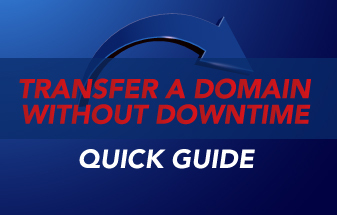
Domains play an extremely essential role in enabling businesses to establish their unique online presence. A domain is essentially the address for your website and is an integral part of your digital branding.
It is, therefore, no surprise that when businesses look to change their domain, they are concerned about the potential for downtime, which could disrupt their operations and hinder their online availability. However, with the right planning and approach, you can easily transfer a domain without downtime.
How do I transfer a domain without downtime?

Domain name transfer is the process of moving your domain from one registrar to another. However, to make sure that this process goes as smoothly as possible without downtime, there are several tips you can use.
Choose a Reliable Registrar
Choosing a reliable registrar that provides quality service and 24/7 professional support is crucial for a smooth domain transfer. That’s why doing some research in order to compare registrars beforehand can save you much time and reduce the risk of encountering complications during the transfer process.
Ensure Domain Settings Remain the Same
When transferring a domain, it is important to ensure that the domain settings, such as the DNS (domain name system) records remain the same. The DNS records contain information that maps your domain name to your website’s IP address, allowing visitors to reach your website. Changing the DNS settings during the transfer process can result in downtime as the changes can take hours or even days to propagate across the web.
Time the Transfer Appropriately
Timing the transfer appropriately is another critical factor in reducing the potential for downtime. Choose a time when your website receives the least traffic and inform your registrar and hosting provider in advance of your intended transfer date. This will give them time to prepare and mitigate any potential errors.
Keep Both Registrars Informed
Keeping both your old and new registrar informed throughout the transfer process is essential. Your old registrar should be aware that you intend to transfer the domain so that they can prepare and provide you with the necessary authorization code or transfer key. Your new registrar should also be aware so that they can inform you of any complications that may arise during the process.
Check for Downtime
After completing the transfer process, monitor your website for any downtime. Check that your website is resolving to the correct IP address and that all functionalities, such as email and forms, are working as expected. It is also advisable to run diagnostic tests to ensure that any errors that may have occurred are identified and remedied promptly.
Domain Transfer Issues
There are several problems faces when you transfer a domain:

Domain Lock
A domain lock, also known as registrar lock or client transfer prohibition, is a safeguard used by domain owners in order to prevent unauthorized transfers of a domain name. While domain lock can prevent domain hijacking, it can also hinder domain transfer, as the domain owner may forget to unlock the domain before transferring it to another registrar or domain owner.
Transfer Codes or Auth Codes
A transfer code, also known as authorization code, is a unique code or password required by some registrars to authorize the transfer of a domain name. Without the correct transfer code, the domain transfer may fail or be delayed.
Time Restrictions
Some registrars may impose time restrictions on domain transfers, such as a 60-day waiting period after domain registration or a recent domain transfer. Such restrictions can limit the domain owner’s flexibility and options for domain management.
Privacy Concerns
Domain transfer can expose the domain owner’s personal or business information, such as name, address, phone number, and email, to the new registrar, which may use it for marketing or other purposes. The domain owner may also lose the privacy protection or WHOIS privacy service provided by the old registrar.
Customer Support
Domain name transfer can be a complex and stressful process, especially for non-technical domain owners. Good customer support and documentation can make a big difference in the success and satisfaction of domain transfer.
Pricing
Domain transfer pricing can vary widely among registrars and depend on various factors, such as the domain extension, the domain’s age, the transfer code, and the hosting plan. Some registrars may offer initial low prices but charge high renewal fees or hidden fees.
In conclusion, transferring a domain does not have to result in downtime, which can negatively impact your online presence and business operations. Just follow our tips and the process should go very smoothly.